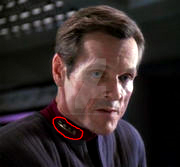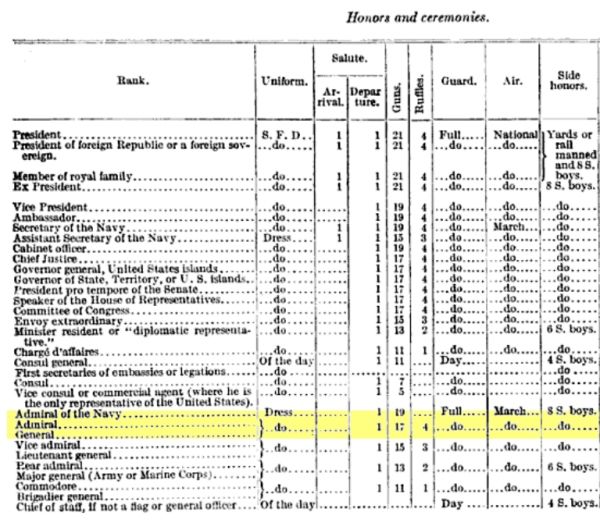Appologies for another thread of this type, but given that several other recurring threads have been picked up lately I thought I'd share some of my recent thoughts.
For the purposes of this discussion, I am assuming that the overall day-to-day business is run by the Commander, Starfleet (nominally a "six-star" under modern terms or O13). All Flag or General Officers wear Gold Insignia.
Below that are four Deputy Commanders - Starfleet Reserves (2-in-C to the Commander, "five star" O12) and three Service Departments (also "five stars"):
Starfleet Exploratory Division (SED, combines UESF plus AG space assets): Primary operator of front-line Starfleet Vessels and Bases.
Starfleet Operational Support Services (OSS, combines TSA, ACSRC & VSC): Supervises all logistical, legal and scientific activities.
Starfleet Ground Forces (SGF, combines MACOs and AG ground assests): Includes Boarding Teams, pre-First Contact observation teams, cultural assistance teams, and Special Operations military reconnaisance/direct action units.
Below this the structure runs:
O11 Admiral or General ("four stars"): Agency Directors and (wartime only) Theatre or Numbered Fleet Commanders.
O10 Vice Admiral or Lieutenant General ("three stars"): Agency Deputy Directors, Minor Fleet or Ground Forces Group Commanders.
O9 or 08 Rear Admiral (either) or Major/Brigadier General ("two or one star"): Task Force Commanders, Colonial GF Division or Infantry Brigade Commanders and Specialist Officers covering Regions or Sectors (esp JAG, Security or Intelligence).
Next are the Commissioned Officers, who wear Silver Insignia. First pip/stripe is Department Colour and worn only on Service and Dress Jackets, shirts are Department Colour and have one less (no stripe/pip below LTJG/2LT):
O7 Fleet Captain or Brigadier (four pips or stripes): Command Dreadnought/Explorer-type Starships, embarked Combined Brigades and major Starbases and ground facilities. Some very experienced Specialist Officers may also be promoted to this level. (For example Jean-Luc Picard, Ben Sisko during the DW, Phillipa Louvois)
O6 Captain or Colonel (3 1/2 pips or striples): Command Cruiser-type Starships, also Ground Forces Brigade Staff and experienced Specialist Officers and some Starbases and ground facilities. (examples Kirk, Spock and Janeway).
O5 Commander or Lieutenant Colonel (three pips or stripes): Command Frigate or Escort-Type Starships and most OSS Vessels. Also act as XO/Department Heads on larger starships, bases and Battalion Commanders.
O4 Lieutenant Commander or Major (2 1/2 pips or stripes): Act as XO/Department Heads on starships, bases and command GF companies or minor OSS vessels.
O3 Lieutenant (Two pips or stripes): Also act as XO/Department Heads or Officers on most starships, bases and command GF Companies.
O2 or O1 Lieutenant JG/Ensign or 2nd Lieutenant/Acting Lieutenant (1 1/2 or 1 stripe): Also act as Department Heads or Officers on most starships, bases and command GF Platoons.
OD Acting Ensign/Midshipman (1/2 stripe): Senior Officer Trainees (except Ground Forces) undertaking Field Assignments. Non-substantive rank, delegated authority only.
C1-4 Cadet: Officer Trainees attending Starfleet Academy. Non-substantive rank, delegated authority only over other Cadets.
Last are the Non-Commissioned and Enlisted Personnel:
Non-Commissioned Ranks (wearing bronze are):
E11 Executive Command Master Chief of Starfleet (XCMCSF): Usually ex-SED, acts as SEA to the Commander, Starfleet and Federation Senior Officals. Four pips or stripes + unique Insignia.
E10 Executive CMC or Executive Command Sergeant Major: SEA to the Deputy Commanders. Four pips or striples.
E9/E9a Fleet or Force CMC or Group Command Sergeant Major: SEA to Agency Heads and Deputies, Fleet and GF Group Commanders (O8+). 3 1/2 pips or stripes, Command Badge.
E6a-E8a Command Master Chief to Chief or Command Chief Master Sergeant to First Sergeant: Advisor to Commanding Officers (O5 to O7). Three, 2 1/2 or Two Pips or Stripes, SED Command Badge.
E6-E8 Specialist Master Chief to Chief or Chief Master Sergeant to Master Sergeant: As act as Advisor to Department Heads and Specialist Officers. Also assigned as Senior Training Instructors, particularly at the enlisted Technical and Specialist Academies, and Assistant Platoon Leaders in Ground Forces and SpecOps. Three, 2 1/2 or Two Pips or Stripes, Other Badges.
E5 Specialist 1st Class or Sergeant: Advisor to Department Heads and Officers, may also act as Shift or Section Leaders and embarked Training Instructors. 1 1/2 pips or Stripes, Other Badges.
E4 Specialist 2nd Class or Corporal: Shift/Team Leaders and Trainers. Depending on manpower/mission parameters may also act as Independent Specialist/Technicans. 1 pip or Stripe, Other Badges.
E3a Lance Corporal: Acting rank appointable in Ground Forces. 1/2 pip or stripe. Other Badges.
E3 Crewman 1st Class or Private First Class: First Tour Qualifed Technical or Specialist. No Stripe. Other Badges.
E2 Crewman or Private: Most junior substantive rank. Held while undertaking familiarisation training during First Tour, so not authorised to work alone. No Stripe. Wears Fleet Uniform with Plain Bronze Badge.
E1 Recruit: Non-Substantive/Tempory Rank, held during Basic or Technical/Specialist School. Wears Training Uniform with Black Badge.
As with Officers the first pip/stripe is Department Colour and worn only on Service and Dress Jackets, shirts are Department Colour and have one less (no stripe/pip below Specialist 2nd Class).
Specialist (or Technician) is a generic placeholder (Petty Officer may be used if you prefer) and would be replaced by the enlisted (wo)man's "rating" were known.
The above is a hybrid of existing Starfleet ranks with extrapolated American or British/Commonwealth ranks to fill in the gaps so that the roles and insignia mostly line-up across the levels which IMO they don't based on an "as is" system based on the USN and USMC or Army?
For the purposes of this discussion, I am assuming that the overall day-to-day business is run by the Commander, Starfleet (nominally a "six-star" under modern terms or O13). All Flag or General Officers wear Gold Insignia.
Below that are four Deputy Commanders - Starfleet Reserves (2-in-C to the Commander, "five star" O12) and three Service Departments (also "five stars"):
Starfleet Exploratory Division (SED, combines UESF plus AG space assets): Primary operator of front-line Starfleet Vessels and Bases.
Starfleet Operational Support Services (OSS, combines TSA, ACSRC & VSC): Supervises all logistical, legal and scientific activities.
Starfleet Ground Forces (SGF, combines MACOs and AG ground assests): Includes Boarding Teams, pre-First Contact observation teams, cultural assistance teams, and Special Operations military reconnaisance/direct action units.
Below this the structure runs:
O11 Admiral or General ("four stars"): Agency Directors and (wartime only) Theatre or Numbered Fleet Commanders.
O10 Vice Admiral or Lieutenant General ("three stars"): Agency Deputy Directors, Minor Fleet or Ground Forces Group Commanders.
O9 or 08 Rear Admiral (either) or Major/Brigadier General ("two or one star"): Task Force Commanders, Colonial GF Division or Infantry Brigade Commanders and Specialist Officers covering Regions or Sectors (esp JAG, Security or Intelligence).
Next are the Commissioned Officers, who wear Silver Insignia. First pip/stripe is Department Colour and worn only on Service and Dress Jackets, shirts are Department Colour and have one less (no stripe/pip below LTJG/2LT):
O7 Fleet Captain or Brigadier (four pips or stripes): Command Dreadnought/Explorer-type Starships, embarked Combined Brigades and major Starbases and ground facilities. Some very experienced Specialist Officers may also be promoted to this level. (For example Jean-Luc Picard, Ben Sisko during the DW, Phillipa Louvois)
O6 Captain or Colonel (3 1/2 pips or striples): Command Cruiser-type Starships, also Ground Forces Brigade Staff and experienced Specialist Officers and some Starbases and ground facilities. (examples Kirk, Spock and Janeway).
O5 Commander or Lieutenant Colonel (three pips or stripes): Command Frigate or Escort-Type Starships and most OSS Vessels. Also act as XO/Department Heads on larger starships, bases and Battalion Commanders.
O4 Lieutenant Commander or Major (2 1/2 pips or stripes): Act as XO/Department Heads on starships, bases and command GF companies or minor OSS vessels.
O3 Lieutenant (Two pips or stripes): Also act as XO/Department Heads or Officers on most starships, bases and command GF Companies.
O2 or O1 Lieutenant JG/Ensign or 2nd Lieutenant/Acting Lieutenant (1 1/2 or 1 stripe): Also act as Department Heads or Officers on most starships, bases and command GF Platoons.
OD Acting Ensign/Midshipman (1/2 stripe): Senior Officer Trainees (except Ground Forces) undertaking Field Assignments. Non-substantive rank, delegated authority only.
C1-4 Cadet: Officer Trainees attending Starfleet Academy. Non-substantive rank, delegated authority only over other Cadets.
Last are the Non-Commissioned and Enlisted Personnel:
Non-Commissioned Ranks (wearing bronze are):
E11 Executive Command Master Chief of Starfleet (XCMCSF): Usually ex-SED, acts as SEA to the Commander, Starfleet and Federation Senior Officals. Four pips or stripes + unique Insignia.
E10 Executive CMC or Executive Command Sergeant Major: SEA to the Deputy Commanders. Four pips or striples.
E9/E9a Fleet or Force CMC or Group Command Sergeant Major: SEA to Agency Heads and Deputies, Fleet and GF Group Commanders (O8+). 3 1/2 pips or stripes, Command Badge.
E6a-E8a Command Master Chief to Chief or Command Chief Master Sergeant to First Sergeant: Advisor to Commanding Officers (O5 to O7). Three, 2 1/2 or Two Pips or Stripes, SED Command Badge.
E6-E8 Specialist Master Chief to Chief or Chief Master Sergeant to Master Sergeant: As act as Advisor to Department Heads and Specialist Officers. Also assigned as Senior Training Instructors, particularly at the enlisted Technical and Specialist Academies, and Assistant Platoon Leaders in Ground Forces and SpecOps. Three, 2 1/2 or Two Pips or Stripes, Other Badges.
E5 Specialist 1st Class or Sergeant: Advisor to Department Heads and Officers, may also act as Shift or Section Leaders and embarked Training Instructors. 1 1/2 pips or Stripes, Other Badges.
E4 Specialist 2nd Class or Corporal: Shift/Team Leaders and Trainers. Depending on manpower/mission parameters may also act as Independent Specialist/Technicans. 1 pip or Stripe, Other Badges.
E3a Lance Corporal: Acting rank appointable in Ground Forces. 1/2 pip or stripe. Other Badges.
E3 Crewman 1st Class or Private First Class: First Tour Qualifed Technical or Specialist. No Stripe. Other Badges.
E2 Crewman or Private: Most junior substantive rank. Held while undertaking familiarisation training during First Tour, so not authorised to work alone. No Stripe. Wears Fleet Uniform with Plain Bronze Badge.
E1 Recruit: Non-Substantive/Tempory Rank, held during Basic or Technical/Specialist School. Wears Training Uniform with Black Badge.
As with Officers the first pip/stripe is Department Colour and worn only on Service and Dress Jackets, shirts are Department Colour and have one less (no stripe/pip below Specialist 2nd Class).
Specialist (or Technician) is a generic placeholder (Petty Officer may be used if you prefer) and would be replaced by the enlisted (wo)man's "rating" were known.
The above is a hybrid of existing Starfleet ranks with extrapolated American or British/Commonwealth ranks to fill in the gaps so that the roles and insignia mostly line-up across the levels which IMO they don't based on an "as is" system based on the USN and USMC or Army?
Last edited:




